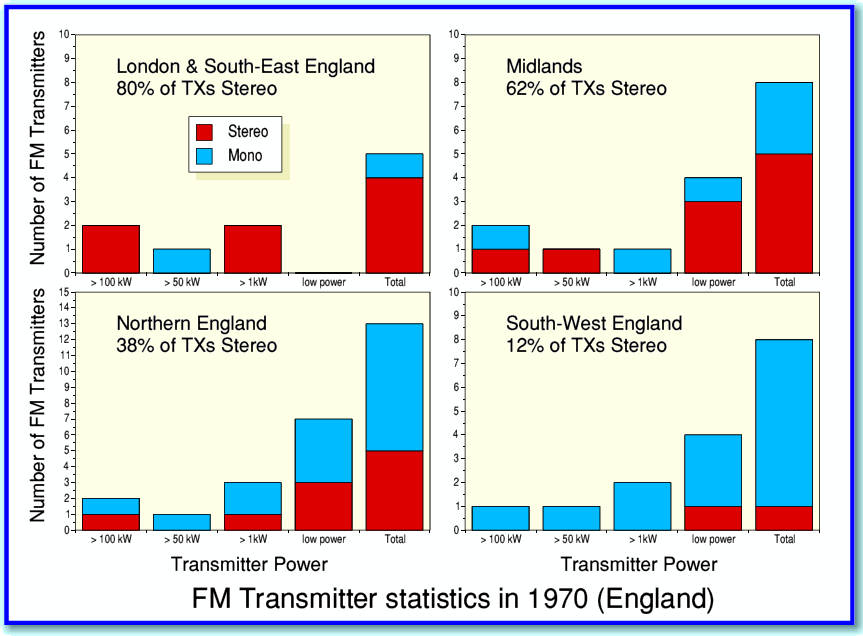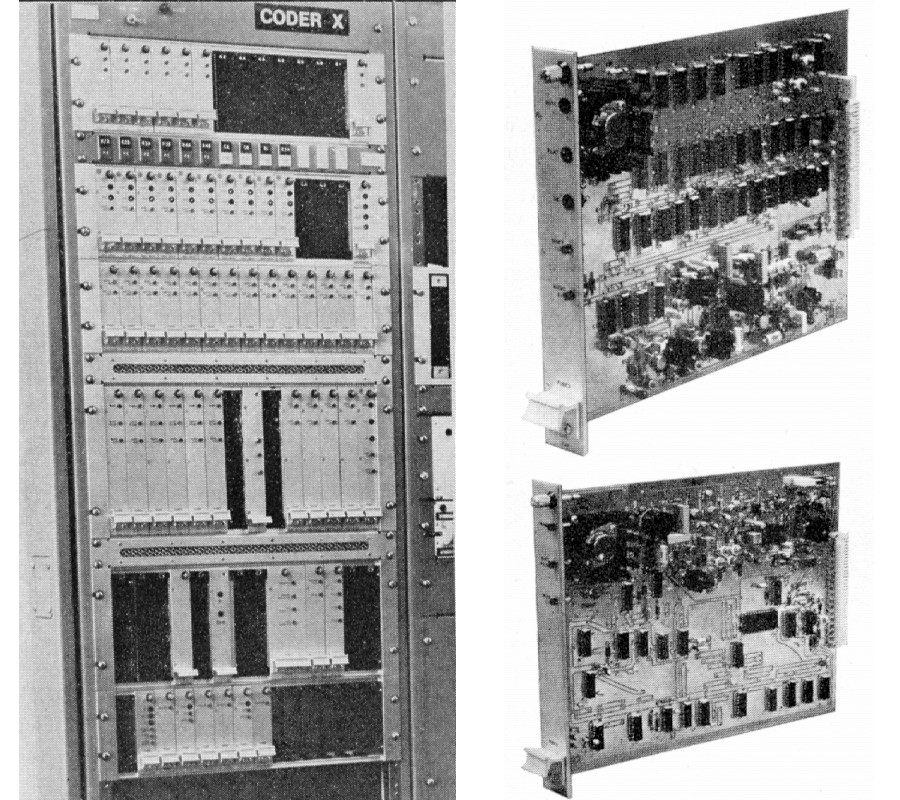 Coder X at Broadcasting House. Coder and Decoder Cards. |
 The map on the left shows the most powerful UK mainland VHF FM Transmitters in 1970. At that time stereo was only available on Radio 3. The other stations were mono only. Radio 1 didn’t even have its own FM transmissions. It had to share some of the Radio 2 provision on a part-time basis.
The map on the left shows the most powerful UK mainland VHF FM Transmitters in 1970. At that time stereo was only available on Radio 3. The other stations were mono only. Radio 1 didn’t even have its own FM transmissions. It had to share some of the Radio 2 provision on a part-time basis.| “A year or so ago we [Hi Fi News] published some noise measurements made of the [stereo] test tones radiated from Wrotham on Radio 3, and it may be remembered that an approximate S/N ratio of only 58dB was average on each stereo channel... The PCM system is now giving a ratio from the output of the continuity desk [at Broadcasting House] to my own receiver of 65dB unweighted. Thus showing an improvement of 7dB over average conditions of the past. The improvement is noticeable mainly at the lowest frequencies with an almost complete elimination of all forms of hum... Although the crosstalk has usually been satisfactory the capability of the new PCM link is so amazing that at 900 Hz the transmitted crosstalk was measured in the early hours of Sunday 17th September and found to be 46dB (which includes the crosstalk of my tuner)... All these improvements have been noticed quite dramatically on relays of the last three Prom concerts... Those capable of receiving the BBC PCM [fed] stereo radio are almost certainly hearing the finest sound quality available in the world.” |
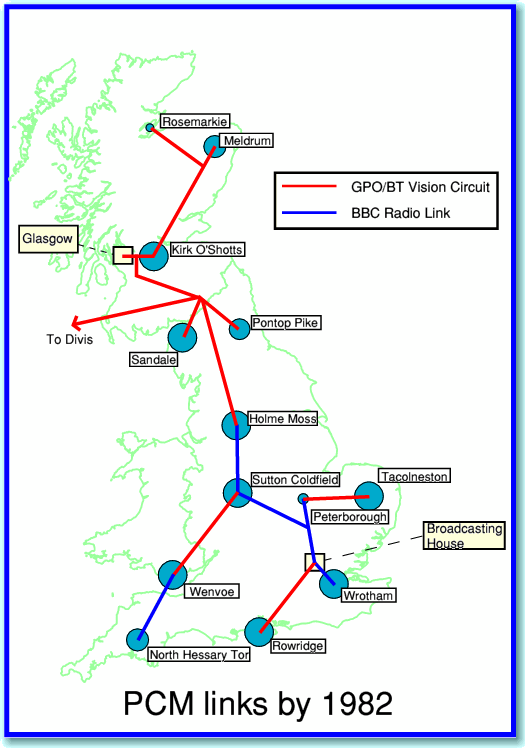 However by the 4th of August 1973 Sutton Coldfield and Wrotham were both using PCM links to broadcast high quality stereo on Radios 2, 3, and 4. This in turn meant that some of their lower power subsidiary transmitters also then provided improved output, although sometimes degraded by having to pass along a non-PCM section for the last part of their journey to the transmitter. By the end of 1975, PCM stereo links had come into operation for many other UK mainland transmitters. With Divis (Northern Ireland) and Tacolneston joining the party by the middle of 1976. Various other links were converted at later dates reaching into the early part of the 1980s.
However by the 4th of August 1973 Sutton Coldfield and Wrotham were both using PCM links to broadcast high quality stereo on Radios 2, 3, and 4. This in turn meant that some of their lower power subsidiary transmitters also then provided improved output, although sometimes degraded by having to pass along a non-PCM section for the last part of their journey to the transmitter. By the end of 1975, PCM stereo links had come into operation for many other UK mainland transmitters. With Divis (Northern Ireland) and Tacolneston joining the party by the middle of 1976. Various other links were converted at later dates reaching into the early part of the 1980s. Coder X at Broadcasting House. Coder and Decoder Cards. |
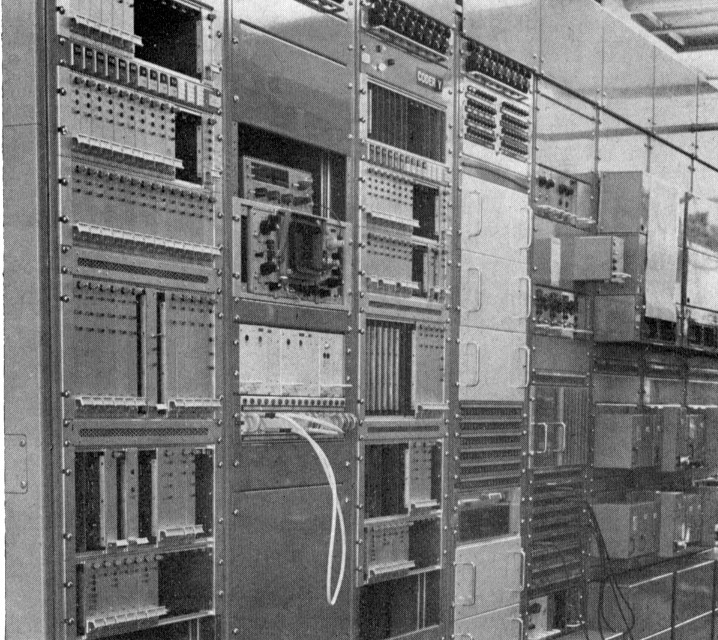 View of PCM coders at Broadcasting House.
|

| 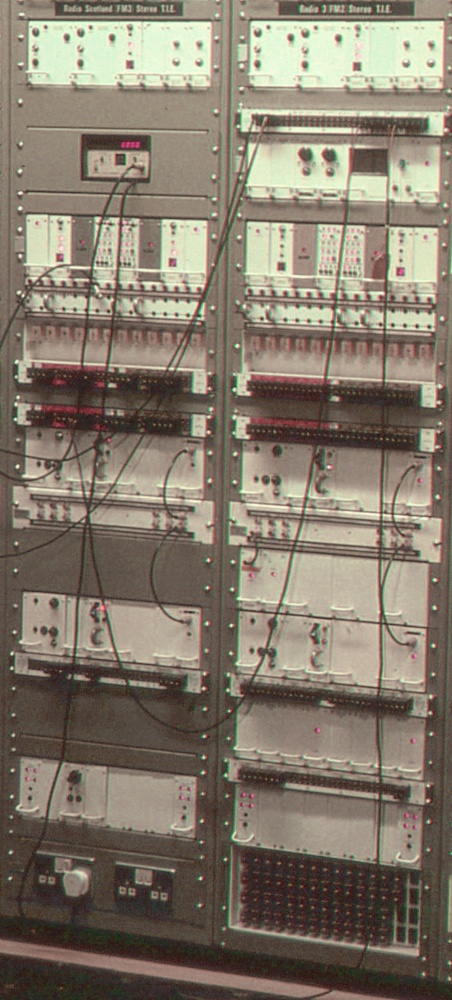 |
PCM Decoders | Transmitter Input Equipment |
Photos kindly provided by Graham Sawdy
| |
| The PCM decoders were not used on alternate days as we heard that the BH coders were. There were less people on the transmitters than in BH to do this sort of thing - basically they were designed for fully unattended operation. The way it worked was that there were two completely duplicate chains, called A and B, right from the PCM decoders through the stereo coders and on to the FM drives (modulators) themselves. The A/B drive changeover changed over the whole lot with an rf switch at the level of a few watts. The output of this was then split to feed the two parallel high power amplifiers taking the output to the final power level. All the A amplifier high power outputs were combined and connected by a feeder up the mast to one ‘half aerial’ the Bs were similarly fed to the other half. This meant that when one ‘side’ was off the power received by the listener was reduced by 6dB. 3dB coming from the halving of the power being transmitted and 3dB from the half aerial aperture giving lower aerial gain. There was generally no reason to prefer either the A or B drive chain though one or other might be specifically chosen if, say, there was temporarily an intermittent fault on the other. The drives would be locked to A or B when work was being carried out on equipment on the other chain. Incidentally, this arrangement often meant that both PCM decoders were in service at the same time - if you wanted to work on one or the other you had to make sure all the downstream equipment was locked to A or B. Although it produced a slight click on the output, station staff felt free to make a drive changeover whenever necessary. The exception was Wrotham where staff were very wary - you could be pretty sure that whenever you did a drive changeover there, BH would be on the control line asking what the click was, because they were monitoring off-air. By the way - I should point out that the various luggage labels were not a normal feature - the pictures were taken during commissioning! |
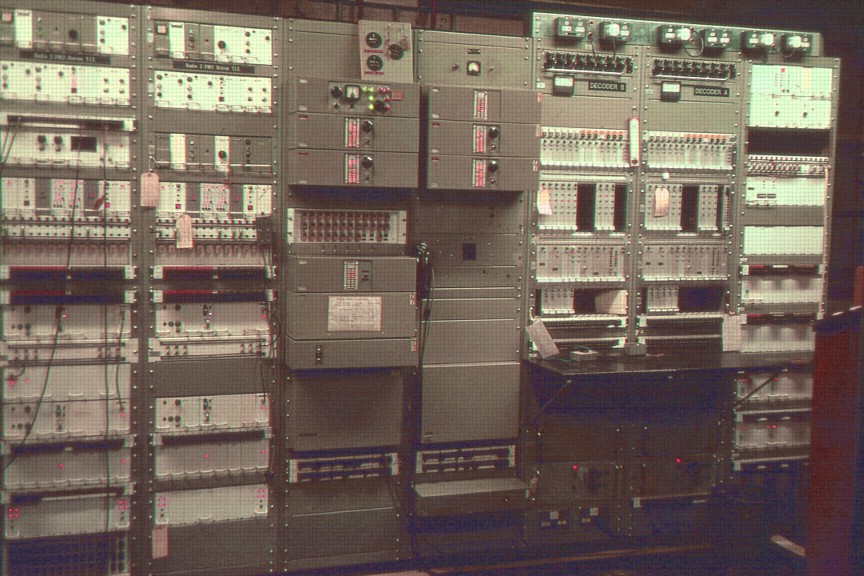
Wider view of the Sandale racks.
Photo kindly provided by Graham Sawdy. |

| “Towards the end of the show, Continuity were convinced the Russians were ecstatically applauding Elton J with rhythmic clapping, and wanted to keep the broadcast running beyond the allotted time. This was a terrible misjudgement of the situation. I had had to pull the audio muting control board from the decoder chassis to keep the link open, as fading on the [microwave] link via L'vov to Goonhilly was dramatically increasing the bit-error ratio. The guy in Continuity was listening to programme-modulated errors - not applause! Fortunately, I managed to convince him that an exit at the scheduled programme junction was necessary for technical reasons.There was much grumbling about the touchy guys from Research Dept., but I was vindicated when the link failed completely a few minutes later!” |
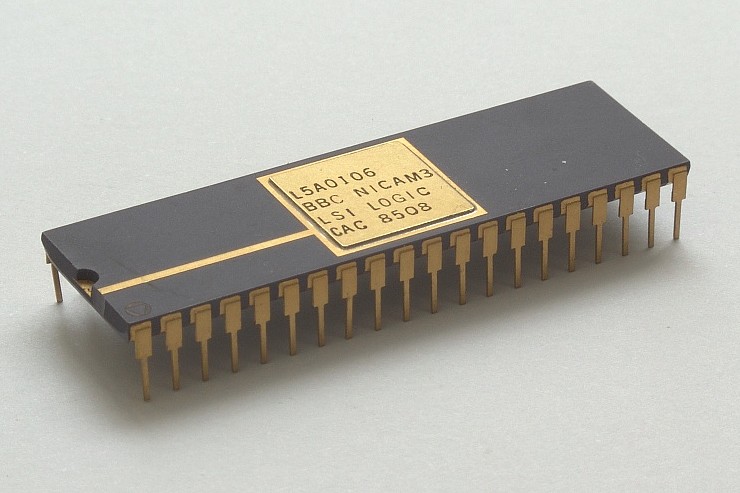
Prototype NICAM IC. The versions installed in the final working units were
rather plain-looking in comparison and lacked the gold trim! Photo kindly provided by John Robinson. |
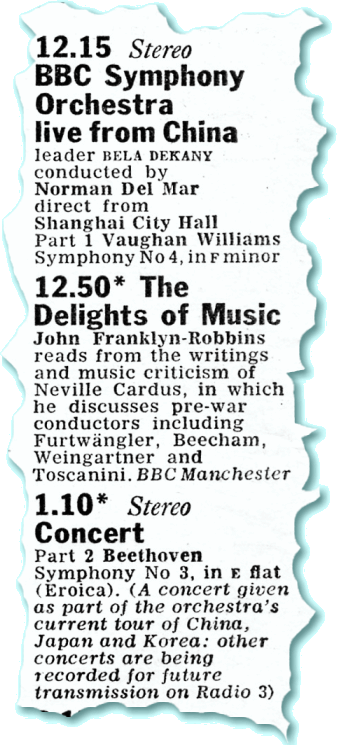 During 1981 however an interesting opportunity appeared to try out the NICAM 3 system in a more demanding and high-profile test. This arose out of the BBC Symphony Orchestra going on a tour, performing concerts in the Far East...
During 1981 however an interesting opportunity appeared to try out the NICAM 3 system in a more demanding and high-profile test. This arose out of the BBC Symphony Orchestra going on a tour, performing concerts in the Far East...|
The [Birmingham - London] trial was very successful, to the extent that it was decided to use it for the high-profile visit of the BBC Symphony Orchestra to China, where one concert, from Shanghai was to be relayed live to Radio 3 at noon London time. ...Nicam provided a solution by using a single video circuit all the way back, from Shanghai to Peking, then by satellite to Madley and so to London. The big risk was that video processors in this chain might seriously damage the waveform of the pulse stream and instructions went out to remove all such devices from the circuit. A comms engineer (Mike Rushmere) took one of the [NICAM 3] coders complete from the Birmingham racks, plus all the cards from the other [London] one to Shanghai, as well as the Nicam 1 prototype which had excelled for Elton John from Moscow.
On Sunday 17th May 1981 the whole design team went to BH Control Room and stood by - just as well because the signal suffered asymmetry making the negative pulses half the size of the positive ones. Slicing this bitstream requires two slicing points halfway up each of the positive and negative pulses. With one side half as high it required one of us to sit watching a scope and adjusting an attenuator to keep the slicer within the smaller pulse height and still above the noise on the other half. As a result the concert took place with a minimum of error problems. John Robinson had beavered furiously to improve the error concealment, so that instead of repeating a previous sample to cover for an erroneous one, a Z80 microprocessor was able to contrive a replacement (14-bit) sample which was an average of the previous and following samples. His new card was in the nick of time for this broadcast. While we were in the Control Room Angus McKenzie, the hi-fi man from Hifi News rang up the BBC and was put through to the Control Room where he congratulated the BBC and the team on the extraordinary quality of the audio, regardless of the distance it had come. |

| “The Concert was held in the City Hall, Shanghai and included Vaughan Williams' 4th Symphony and Beethoven's Eroica Symphony, ending with an astonishing encore in which the orchestra really let themselves go, called 'Bearing the Good Tidings from Peking to the Mountain Villages'... Listening to my tape in retrospect, I am still just as impressed as I was the first time, not only with the playing of the orchestra, conducted by Norman Del Mar, but with the remarkable sound quality of the new digital link system.” |
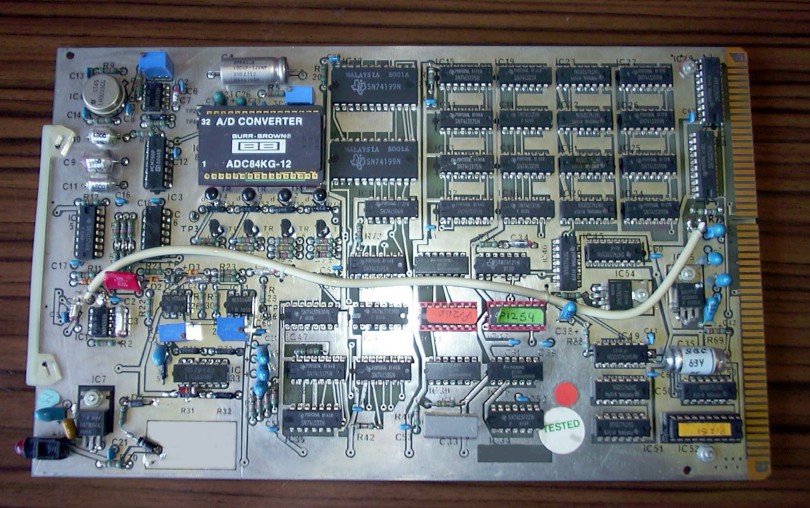
NICAM ADC card. Photo kindly provided by Neil Gilchrist
|
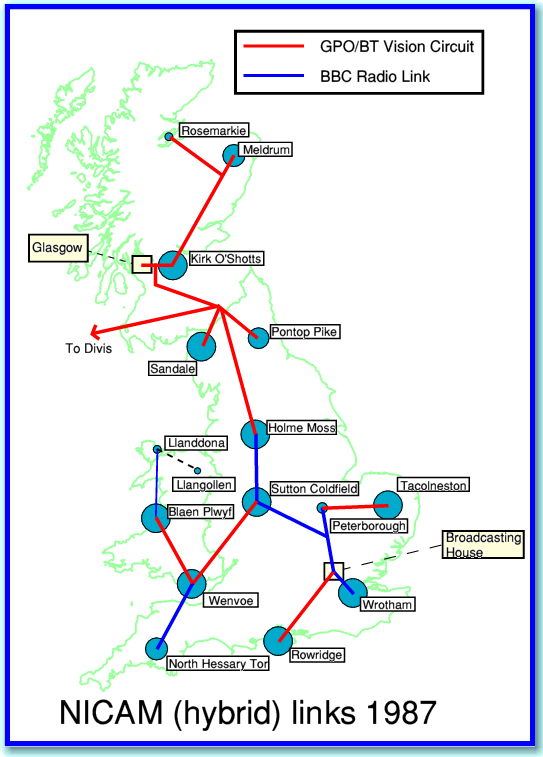 The first ‘hybrid’ 8 Meg links were bought into use feeding the Wrotham, Peterborough, Sutton Coldfield, and Holme Moss transmitters on the 15th of January 1986. Various detailed modifications and remedial work then had to be done to further extend the 8 Meg distribution. This let the NICAM reach other transmitters, reaching Sandale, Pontop Pike, Divis, and Kirk O’Shotts by the end of May 1986.
The first ‘hybrid’ 8 Meg links were bought into use feeding the Wrotham, Peterborough, Sutton Coldfield, and Holme Moss transmitters on the 15th of January 1986. Various detailed modifications and remedial work then had to be done to further extend the 8 Meg distribution. This let the NICAM reach other transmitters, reaching Sandale, Pontop Pike, Divis, and Kirk O’Shotts by the end of May 1986.